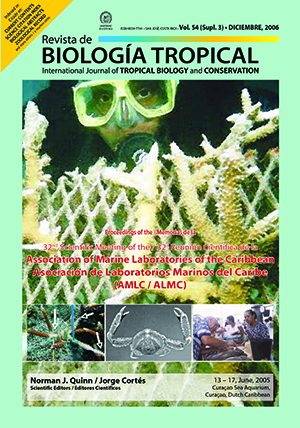Abstract
Sexual recruitment of the staghorn coral, Acropora cervicornis, is accepted to be very rare. Instead, these branching corals proliferate through fragmentation leading to dense mono-specific and possibly monoclonal stands. For acroporid corals, which have suffered drastic population declines, dominance of asexual reproduction results in low levels of genotypic diversity and limited ability to re-colonize extirpated areas. Small colonies with a single encrusting, symmetrical base, and few incipient branches are frequently presumed to be the result of a settled planula (i.e. sexual reproduction). Here, we show that colonies fitting this description (i.e., presumed sexual recruits) can result from asexual fragmentation. Acropora cervicornis colonies (~20 cm diameter) were tagged and observed over eighteen months. In several cases, colony offshoots fused with the adjacent substrate forming secondary disc-like attachment points. Following natural fragmentation, these discs of tissue became separated from the original colony, and were observed to heal and give rise to smaller colonies with striking similarity to the expected morphology of a sexual recruit. Thus, presuming a colony is a sexual recruit based on appearance is unreliable and may lead to inflated expectations of genetic diversity among populations. The accurate assessment of recruitment and genetic diversity is crucial to predicting the recovery potential of these imperiled and ecologically irreplaceable reef corals. Rev. Biol. Trop. 54 (Suppl. 3): 145-151. Epub 2007 Jan. 15.References
Anonymous. 2006. Endangered and Threatened Species: Final Listing Determinations for Elkhorn Coral and Staghorn Coral. Federal Register 71: 26852-26872.
Baums, I.B., M.W. Miller & M.E. Hellberg. 2006. Geographic variation in clonal structure of the Caribbean reef-building coral Acropora palmata. Ecology. Mono. 76(4): 503-519.
Bruckner, A.W. 2003. Proceedings of the Caribbean Acropora Workshop: Potential Application of the U.S. Endangered Species Act as a Conservation Strategy. NOAA Tech. Memo NMFS-OPR-24. 184 p.
Gilmore, M.D. & B.R. Hall. 1976. Life history, growth habits and constructional roles of Acropora cervicornis in the patch reef environment. J. Sed. Petr. 46: 519-522.
Knowlton, N., J.C. Lang & B.D. Keller. 1990. Case study of natural population collapse post-hurricane predation on Jamaican staghorn corals. Smiths. Contrib. Mar. Sci. 31: 1-25.
Quinn, N.J. & B.L. Kojis. 2005. Patterns of sexual recruitment of acroporid coral populations on the West Fore Reef at Discovery Bay, Jamaica. Rev. Biol. Trop. 53 (Suppl. 1): 83-89.
Ruiz-Zárate, M.A.& J.E. Arias-González. 2005. Recruitment of Acropora, Millepora and Stylaster roseus on an experimental substratum. Coral Reefs 24: 56.
Rylaarsdam, K.W. 1983. Life histories and abundance patterns of colonial corals on Jamaican reefs. Mar. Ecol. Prog. Ser. 13: 249-260.
Sammarco, P.W. 1980. Diadema and its relationship to coral spat mortality: grazing, competition and biological disturbance. J. Exp. Mar. Biol. Ecol. 45: 245-272.
Tunnicliffe, V. 1981. Breakage and propagation of the stony coral Acropora cervicornis. Proc. Natl. Acad. Sci. 78: 2427-2431.
Van Moorsel, G.W.N.M. 1989. Settlement of stony corals (Scleractinia) on artificial substratum on a Caribbean reef: spatial aspects. Ph.D. Diss, Rijksuniversiteit, Groningen. 104 p.
Vargas-Angel, B. & J.D. Thomas. 2002. Sexual reproduction of Acropora cervicornis in near-shore waters off Ft. Lauderdale, Florida (USA). Coral Reefs 21: 25-26.
Williams, D.E. & M.W. Miller. 2005. Coral disease outbreak: pattern, prevalence, and transmission in Acropora cervicornis. Mar. Ecol. Prog. Ser. 301: 119-128.
Williams, D.E., & M.W. Miller 2006. Importance of disease and predation to the growth and survivorship of juvenile Acropora palmata and Acropora cervicornis: a demographic approach. Proc. 10th Int. Coral Reef Symp. 1096-1104.
##plugins.facebook.comentarios##

This work is licensed under a Creative Commons Attribution 4.0 International License.
Copyright (c) 2006 Revista de Biología Tropical






